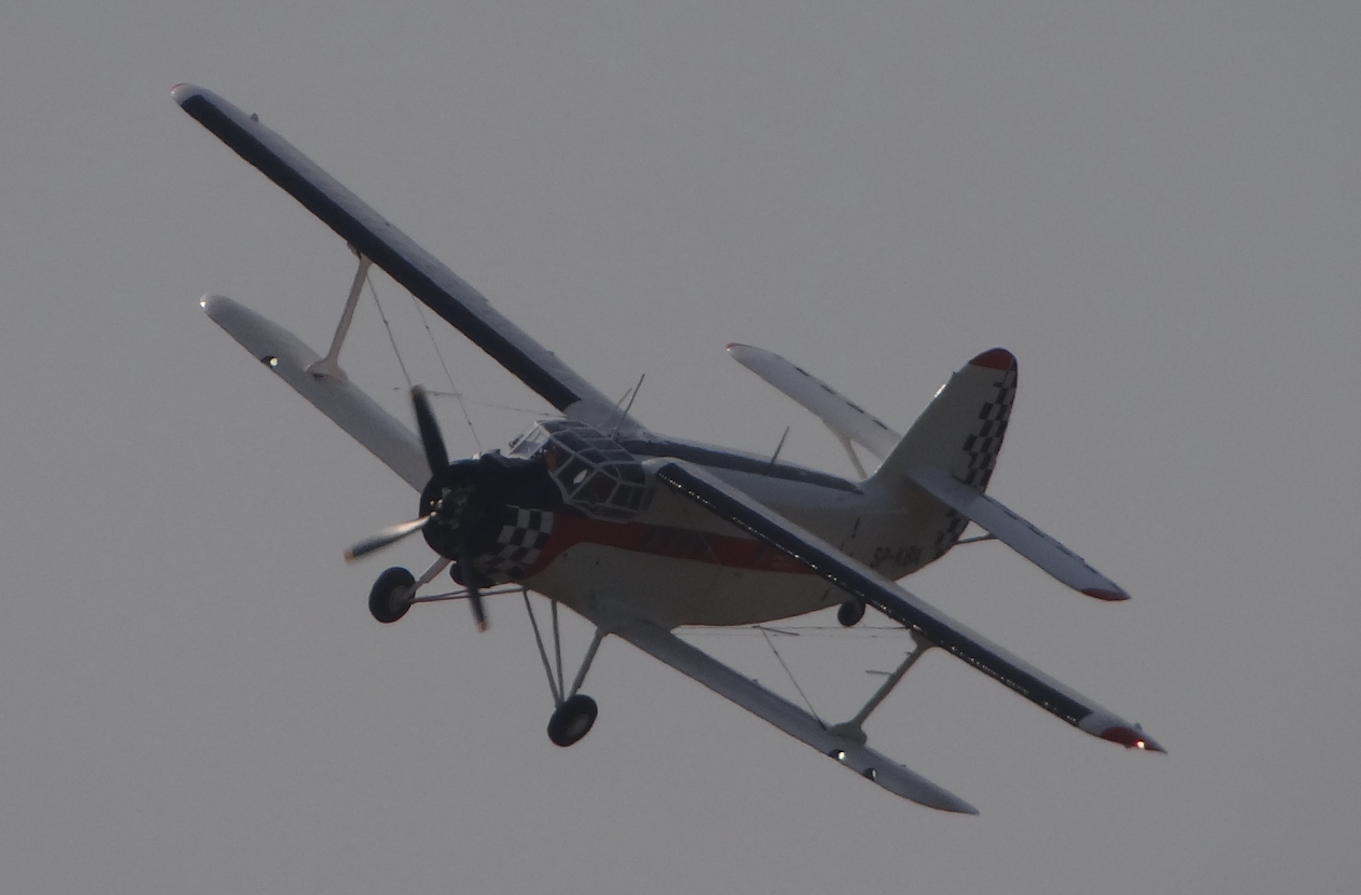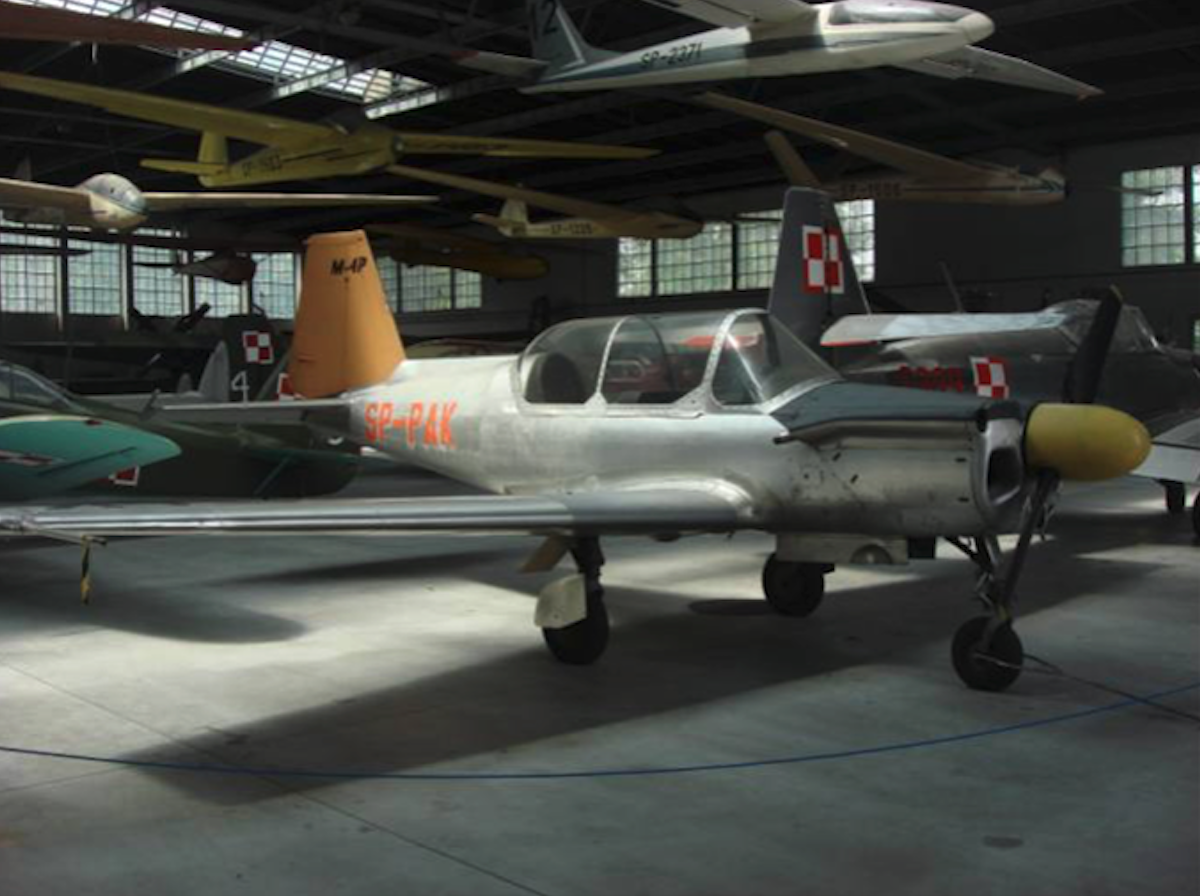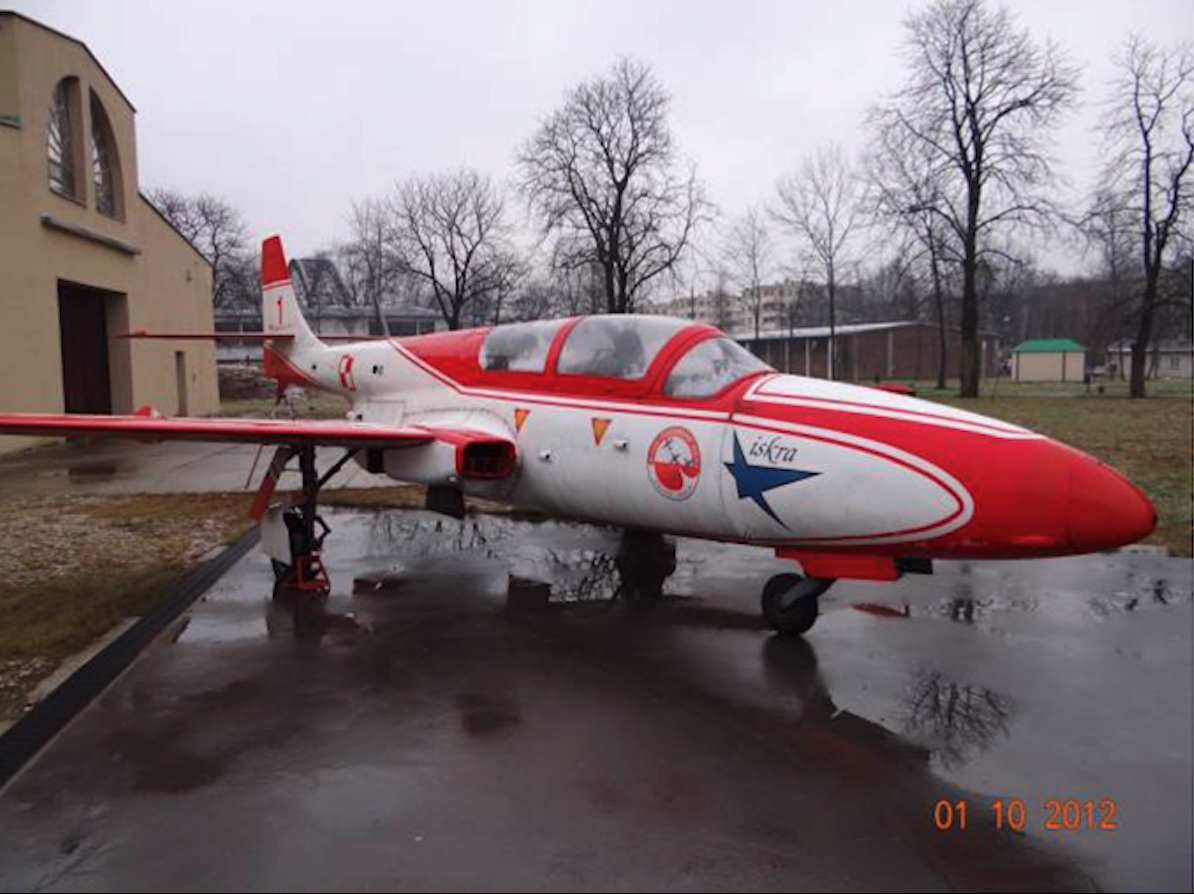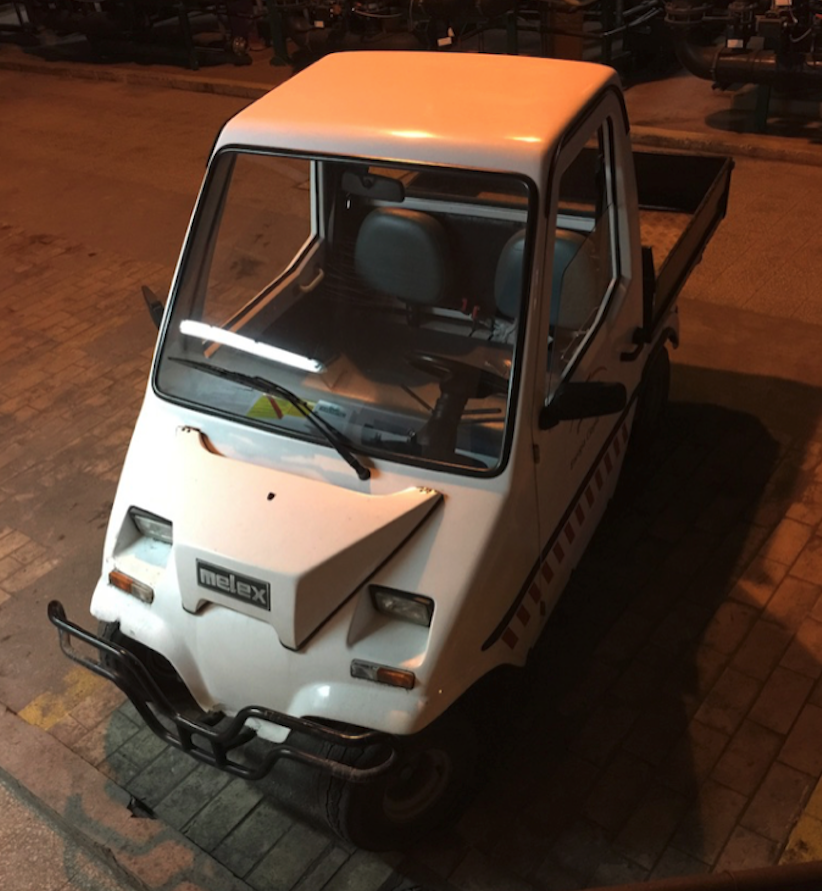Kraków 2012-03-20
Państwowe Zakłady Lotnicze - Communication Equipment Factory - Mielec.
PZL / Antonow An-2.
The An-2 planes were very much needed by the Russians. However, they had no processing capacity. Their factories were charged with the production of combat aircraft. The Russians, looking for a new factory for the production of An-2 planes, held talks with both Poland and the GDR (German Democratic Republic) and Czechoslovakia. The choice of a factory in Poland was more a political than a substantive one. Let us recall that during this period in Poland, tests were carried out on the new MD-12 passenger and transport aircraft, ahead of the An-2 by two generations. The Kremlin rightly concluded that the Russian monopoly could be disturbed. By locating the production of An-2 in Poland, guaranteeing the receipt of these aircraft, it was almost 100% certain that the MD-12 program would collapse. And that's how it happened. CCCP sold Poland the rights to produce An-2, concluding a commercial contract for long-term deliveries of these aircraft.
In 1959, WSK Mielec received the license documentation and the model aircraft No. 111519 produced in 1959. The plane was registered in Poland under the SP-ANA mark and production started. The first 10 machines were assembled from parts supplied with the CCCP.
The first Polish An-2 made its first flight on October 23, 1960, and the pilot was Tadeusz Gołębiewski. The employees of WSK Mielec quickly mastered the new technology and from January 1961, mass production of components made exclusively in Poland began. One of the largest sub-suppliers was the WSK Okęcie plant. It produced vertical and horizontal tail, floats for the water version, and chemical tanks for the agricultural version. On March 23, 1961, the first batch was handed over to recipients from the East.
In 1961, the production of ASz-62 IR engines with a capacity of 1 x 736 kW (1 x 1,000 HP) began under license at the WSK Kalisz plant.
The Institute of Aviation made a significant contribution to the modernization of this outdated structure, which was An-2. In 1962, comprehensive tests of the An-2 manufactured in Poland began there. As a result, many elements were improved and modernized, while making the machine safer. In 1965, chemical spreading and spraying equipment was tested in IL.
An-2 planes, of Polish production, were purchased by; Bulgaria, Hungary, Romania, Yugoslavia, East Germany, Czechoslovakia, Democratic Korea and Mongolia. These planes were also purchased by Western countries; in 1973 several machines were sold to France, in 1974 they were bought by Turkey, the Netherlands and England. In general, during the entire production in Poland, the planes were exported to 15 countries on 4 continents. They were operated in climates with temperatures ranging from -50 degrees C to +50 degrees C.
The production of An-2 was impressive. There were years when over 500 units were built each year. On February 3, 1973, the 5,000-year-old unit for the CCCP was built. It was propagandized that the plane was built in a community effort, as a gift from the WSK Mielec crew to the country of councils. By December 31, 1975, 8,300 units were produced, of which over 7,000 were transferred to the CCCP.
By the end of 1979, 9,300 An-2 aircraft had been built. WSK Kalisz built 14,500 ASz-62 IR engines. The production of the An-2 aircraft in Poland ended in 1986, but over the next few years, small series were created at the request of specific customers. In the period from 1960 to 2002, WSK PZL Mielec produced 11,915 copies. The last 4 planes intended for Vietnam were built at WSK Mielec in January 2002. Of the planes produced in Mielec, 10,605 were sold to CCCP, 842 to other countries, and 468 to users in Poland. The production is a world record for the production of peacetime aircraft. In Mielec, the An-2 plane was replaced on the production line by the An-28 plane.


PZL M-4 Tarpan. 1960 year.
The PZL M-4 plane was designed for the needs of the Polish Aero Club as a training plane with a retractable three-wheeled landing gear. The design was based on the earlier PZL M-2 project. The basic variant was to be the M-4 P, used for navigation training. Work began in 1958 and the first prototype was built in 1960. Due to the long development time of the engines, the first flight took place on September 7, 1961. (registration of SP-PAW).
The research showed that the weight was much higher than estimated (890 kg instead of 748 kg) due to design changes. In July 1964, the second prototype was tested (SP-PAK registration). The flight characteristics and stability of the M-4 were assessed as good. The cabin offers excellent visibility for the crew and the plane was very successful overall. However, due to the too high price, the Polish Aero Club decided not to order the plane and production did not start. Also, the development of the flat version of the PZL WN-6 engine was cumbersome and was eventually rejected.

Home refrigerators from WSK Mielec.
In Poland, the first refrigerator was manufactured in Wrocław in 1956 and was called Mewa. Affordable refrigerators became in high demand at the time. At the turn of the 1950s and 1960s, a decision was made to start the production of refrigerators at WSK PZL Mielec. The refrigerator had no fancy name, just WSK Refrigerator. The production of refrigerators in Mielec lasted for about 4 years.
PZL M-11. 1961 year.
In 1961, engineers Telesfor Myszka and Stanisław Jachyra started work on a multi-role aero-van plane. The work did not go beyond the preliminary design.
PZL M-12.
In 1961, engineer Alfred Baron started working on an agricultural plane. It was to be a two-seater agricultural, metal, high-wing, twin-engine airplane, fuselage with a tail beam and double vertical tail. Work lasted until 1962 and turned into a multi-role aircraft design, which was designated PZL M-12 A. Versions were developed; passenger, cargo, sanitary, photographic, amphibious. The plane was also to be operated in polar conditions and with floats on the water. The works were carried out in the period 1963-1964.
The PZL M-12 plane should not be confused with the PZL 12 plane, which was a water-plane (flying boat) flown in February 1931.
PZL M-13.
Also in 1961, the engineer Telesfor Myszka made an attempt to build a passenger plane that could transport 24-32 passengers. Metal construction. The propulsion was to be two turboprop or turbojet engines. Work on the project lasted from 1961 to 1962.
The PZL M-13 aircraft should not be confused with the PZL-13. PZL-13, it was a project of a six-seater passenger plane designed in 1931 by Eng. Stanisław Prauss at Państwowe Zakłady Lotnicze in Warsaw.
TS-11 Iskra. 1963 year.
On February 5, 1960, the career of the most famous training aircraft of the second half of the 20th century, the TS-11 Iskra, began. It was on this day that the prototype made its first flight. When the decisions on serial production were made, the PZL Mielec plant began to prepare from 1962 to its start. The head of the design office established at PZL WSK Mielec in order to implement the aircraft into serial production was the constructor engineer Kazimierz Gocyła. Under his supervision, the technical documentation for the serial aircraft was developed and production was launched under the designation TS-11 Iskra bis A. The design was given the designation 1H. The first flight of the TS-11 Iskra No. 1H 01-01 aircraft built in Mielec was performed on November 7, 1963. The pilots were Zbigniew Słonowski and Tadeusz Prożych. An information series was prepared, which was put into trial use at the School Air Force Unit. Thanks to the good cooperation of all interested parties; the obtained results were taken into account, a number of corrections were made in the airplanes. It was at this stage that the fuel tanks were placed in the wings. Engineers participated in the work on the improvement of the aircraft; Jerzy Bar, Adam Borowski, Jerzy Kieroński and Ryszard Łęczycki. In total, between 1964 and 1965, 54 units were built in 3 production series, from 1H 01-01 to 1H 03-22, powered by HO-10 engines. After the corrections, the plane was designated TS-11 Iskra bis.
On June 6, 1967, the pilot Michał Skowroński made the first flight on the TS-11 Iskra bis II aircraft No. 1H 03-26.
On June 26, 1968, pilot Michał Skowroński made the first flight on the TS-11 Iskra 100 prototype aircraft No.H 03-30.
On August 27, 1969, the pilot Michał Skowroński made the first flight on the series TS-11 Iskra bis B aircraft No. H 05-01.
On June 22, 1972, the pilot, Michał Skowroński, made the first flight on the TS-11 Iskra BR prototype No. 4H 08-23.
On September 19, 1973, the pilot Stanisław Wasil made the first flight on the TS-11 Iskra SB prototype No. 3H 07-20.
In 1973, serial production of the TS-11 Iskra bis D was launched.
On April 18, 1975, pilot Michał Skowroński made a test flight of the TS-11 Iskra 200 aircraft No. 2H05-30.
In 1975, production of the TS-11 Iskra bis C aircraft began.
In 1981, the first serial TS-11 Iskra bis DF plane was tested.

PZL Mielec Engine Factory. 1968-2007.
The decreasing production of aircraft and the great potential of the PZL Mielec company resulted in the establishment in 1968 of a new production plant, which was called Wytwórnia Motników PZL Mielec. The products of the new plant were to be internal combustion engines, mainly diesel ones. The Polish economy badly needed engines to drive trucks, buses, agricultural and construction machinery, military vehicles, marine drive units, large compressors, power generators and large pumps. The WSK PZL Mielec Engine Manufacturing Plant was one of the three Polish plants producing traction motors, next to WSW Andrychów and the Starachowickie plant.
At the beginning of the 70s of the 20th century, there was a certain opening of Poland to the West. It allowed to obtain new technologies and products. At that time, a license was purchased for the production of English Leyland engines, used mainly to drive trucks and buses. The production of the Leyland SW 680 and SWT 11 engines has started at the PZL Mielec Engine Factory.
In 1997, the production of MD 111 E engines began. Since 2003, engine production has been systematically limited to just a few engines per year. Even though there were orders. In its heyday, the company employed around 1,000 people. For several years, until 2005, the management board of Wytwórnia Motników reduced employment from approx. 700 people to approx. 300.
However, the socio-economic changes in Poland did not turn out to be good for the company. Before the bankruptcy took place, the ownership structure of PZL Mielec Engine Factory changed several times. The co-owners of the company were such entities as; Pekao Fundusz Kapitałowy, PKN Orlen, Autocentrum and others. In 2002, the company was heavily indebted, but still had orders and a market. However, this was lost to private companies developing at its expense. In 2005, a new Polish investor appeared. In June 2006, the plant's privatization process was completed. For a moment it seemed that good times were returning for the company, because the new owner had ambitious plans. But these plans were blocked. The engine production was discontinued in 2006 and was not restarted due to non-compliance with European Union standards. In 2008, the plant's fixed assets began to be sold. The production line for the assembly of Leyland engines has been sold - for scrap. The management board sold the H-20 hall with an area of approx. 7,000 square meters. The Engine Manufacturing Plant ceased operations on June 30, 2007.
PZL Mielec Engine Manufacturing Plant, a company with great traditions, has gone down in history. Its history is a model example of a missed opportunity in the Republic of Poland. It is true, however, that the engines no longer met the highest EU environmental standards.
Already in 1999, the Mielec Diesel Gaz company was established in the special economic zone of Euro Park Mielec from a part of the assets of Wytwórnia Motników and the funds from the capital of the National Fund for Environmental Protection and Water Management. The company dealt with the conversion of diesel buses to run on ecological natural gas.
PZL M-14. 1969 year.
In 1969, engineers Adam Borowski and Andrzej Frydrychewicz started designing a metal agricultural aircraft. At the same time, it was planned to develop a two-seater school version. Work was discontinued in 1971.
The PZL M-14 aircraft was to replace the agricultural version of the An-2 aircraft. The project was a joint work of PZL Mielec and PZL Okęcie. The main works were carried out in the newly created Experimental Station WSK PZL Mielec. In 1970, work on the plane was transferred to the Institute of Aviation.
However, at that time, Polish-Soviet talks were already underway on the production of agricultural aircraft for the needs of the CCCP. In April 1971, a convention was held under the chairmanship of Stanisław Wyłupek, Deputy Minister of Machine Industry. On the Polish side, there were representatives of PZL Mielec and a delegation from the Ministry of Civil Aviation. On the Soviet side, there were representatives of the Ministry of Aviation Industry of the CCCP. The Polish side presented the technical specification translated into Russian and the design of the PZL M-14 agricultural aircraft. At the same time, they asked to send a Russian constructor from CCCP who would lead the program and adapt the plane to the needs of that market. It almost happened. But the Russians, in addition to their designers, sent a new agricultural aircraft project, the future PZL M-15 Belphegor.
PZL Mielec employees were forbidden to mention the PZL M-14 program. It was logical. There was no intention to annoy big brother. There was a certain outlet for the future production of the M-15. It was also expected that the funds for research and development works would be much larger. Additionally, the mosquitoes announced that the TWD-10 engine would not be produced, and that it was to power the M-14 aircraft. Later, they promised to transfer a license to manufacture TWD-10 A turboprop engines, with a ban on mounting them on M-14 aircraft. The use of the French Turmo III engine from Turbomeca was considered for some time. The PZL M-14 program had to be closed.
For several years, the M-14 model was on display at the Workers' Cultural Center in Mielec. The plane was supposed to be a low-wing low-wing aircraft. A tank for 2 200 kg of chemicals was placed in front of the crew cabin. The ends of the rectangular wings were to be folded for easy hangaring.
Electric vehicle Melex. 1970.
Melex is a small electric vehicle produced in Mielec since 1971 and still.
In the 1960s, electric golf carts in the US were already commonplace. One of the Yankee distributors of these strollers decided to look for other manufacturers in the world to have a larger offer and more competitive prices. The project aroused interest in Poland, and additionally was quite a challenge at that time. The subject was taken up by the Experimental Station in Mielec. Based on two trolleys from the USA, the designers prepared a prototype of a new one. As a result, a new golf cart called Melex was created. In 1970, a batch of 10 was built and sent to the US for testing. The product turned out to be successful. Its serial production was launched in 1971 in the newly created department of the WSK Mielec aircraft factory.
Polish Melex managed to obtain a 10% market share there. The company proved to be highly competitive as its products were distinguished by both good quality and relatively low price, which put American producers at a disadvantage. And so there was the first turning point. In 1975, an anti-dumping duty was imposed on the company, which initiated a lawsuit that lasted many years. Although Melex ultimately won the case, it took its toll, significantly weakening its position in the US market. On December 13, 1981, communist general Wojciech Jaruzelski introduced martial law in Poland. As a result, US President Ronald Reagan introduced an embargo on goods from Poland, which resulted in a 50% decrease in sales.
Reflecting on a way out of the situation, Melex decided to break free from the US and expand geographically by expanding into European markets. Soon after, thanks to the PEZETEL Foreign Trade Company, Melexa products appeared in Scandinavian countries, in Italy, France, Great Britain and outside Europe, i.e. in Argentina, Australia or African countries. In addition, the range of products had to be expanded and used beyond the golf course. It turned out that Melex can be used as a means of transporting goods and people over short distances, which additionally helped the company to prosper in the following years.
The streak was interrupted by the turmoil of socio-economic changes in the Republic of Poland. As a result of ownership changes, in 1993, several companies were separated from the property of Wytwórnia Hardware Komunikacyjnego PZL Mielec, including Wytwórnia Pojazdów Melex Sp. z o.o. In confrontation with the market reality, the company did not manage to cope with financial problems. In 1996, an agreement was signed with a strategic investor, PEZETEL, which recapitalized the company and prepared a "face lifting" of the existing products to attract customers.
Unfortunately, the combination of many unfavorable events around the company led to its bankruptcy in February 2004. However, the company was successfully bought in full as an operating enterprise by the states of Dorota and Andrzej Tyszkiewicz on September 1, 2004. The company began to operate as a general partnership under the name Melex A&D Tyszkiewicz. As a long-time employee and then the general director of the Warsaw-based Fabryka Samochodow Osobowych, Mr. Andrzej Tyszkiewicz had extensive experience in the automotive industry. The brand has revived and since then everything has been going in the best direction. Original Melex vehicles are used, among others, on golf courses, factories, logistic centers, sanatoriums, hospitals, funeral companies, airports, stations, parks, zoos, closed areas, such as old towns of large cities.

PZL LLM-15 / PZL M-15 Belphegor. 1973 year.
In 1971, Poland received an order from the Soviets to develop, build and produce the world's first agricultural aircraft with a turbojet drive. This task was commissioned to the office in Mielec. The initial assumption was developed in the CCCP by engineer R. Izmaiłow. In Poland, the work was led by engineer Kazimierz Gocyła, and they began in 1972. In order to successfully develop the construction of this futuristic aircraft, it was necessary to conduct research on a flying laboratory based on the An-2 aircraft. The machine was designated PZL LLM-15 No. XM-15 and was flew on May 27, 1973 by the test pilot, Ludwik Natkańca. The collected experience was used to build the target structure, which was designated PZL M-15. On January 9, 1974, pilot Tadeusz Gołębiewski made a test flight of the PZL M-15-00 prototype No. 1SP 01-02. The plane was given the unofficial name of Belphegor.
On April 25, 1975, the pilot Tadeusz Gołębiewski made a test flight of the first serial M-15 aircraft No. 15 002-01.
On December 30, 1975 pilot Andrzej Pamuła made the first flight on the prototype of the M-15-40 aircraft No. 1S 001-04, and on July 19, 1976, pilot Adam Gruba made a serial test flight of PZL M-15-40 No. 1S 006-01 .
On August 23, 1976, the pilot Stanisław Wasil flew the PZL M-15-03 serial prototype No. 1S 006-02, and on October 9, 1976, the pilot Tadeusz Podlecki, another serial PZL M-15-03 No. 1S 006-03.

PZL M-18 Dromader. 1976 year.
In 1974, a team led by engineer Józef Oleksiak started working on a classic agricultural plane. The aircraft was designated PZL M-18 Dromader. The PZL M-18 Dromader prototype no. 1ZP 01-02 registration SP-PBW was flew on August 27, 1976 by the pilot Andrzej Pamuła.
On October 2, 1976 pilot Tadeusz Gołębiewski flew the first serial PZL M-18 Dromader No. 1ZP 01-03 registration SP-PBZ. On April 14, 1978, pilot Tadeusz Gołębiewski flew PZL M-18 Dromader No. 1Z 001-01, registration SP-PSV, and on September 7, 1978, the same pilot made the first flight on another PZL M-18 Dromader No. 1Z 001- 05 registration of SP-PBT. On January 15, 1982, a new version of the PZL M-18 A Dromader No. 1Z 004-05 aircraft was tested. In March 1984, the serial PZL M-18 A Dromader was tested. On March 21, 1988, pilot Henryk Bronowicki flew the modernized PZL M-18 AS Dromader No. 1Z 014012, registration SP-PBO.

Written by Karol Placha Hetman
